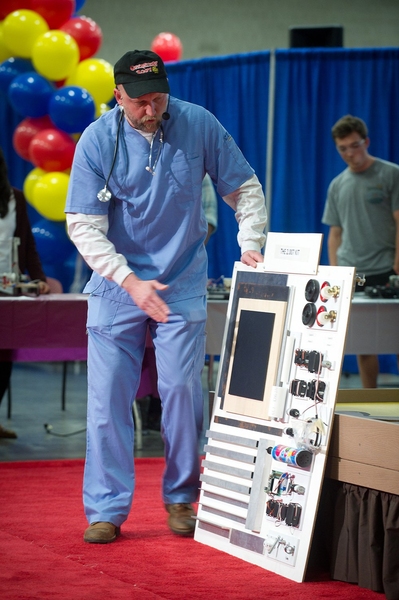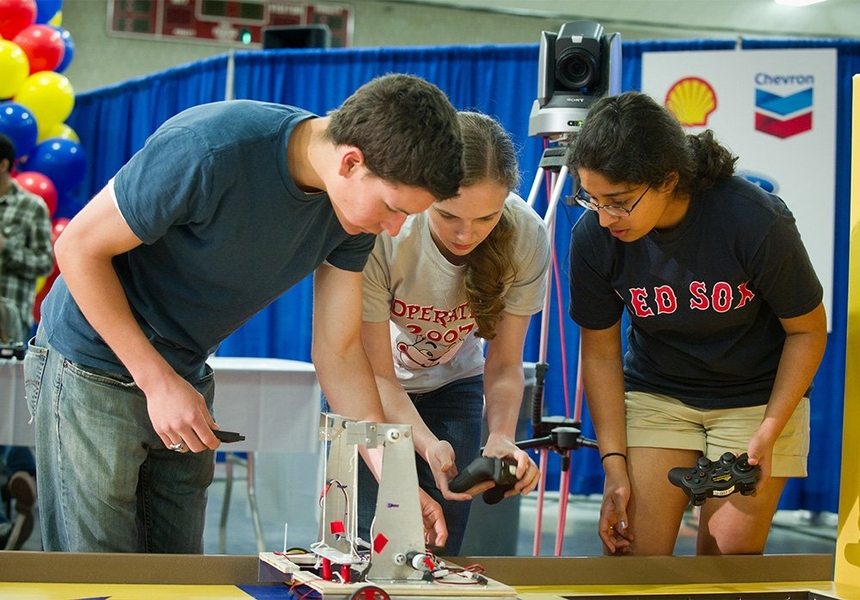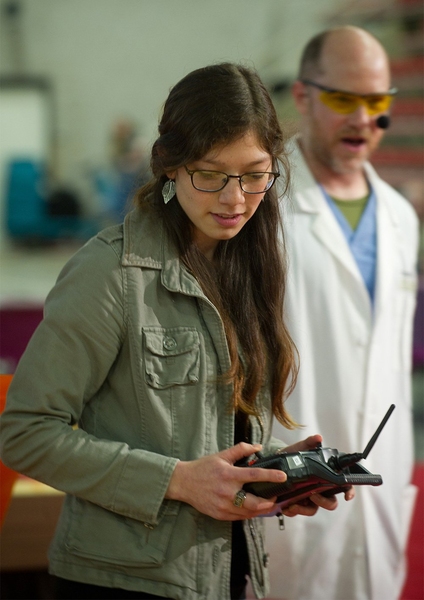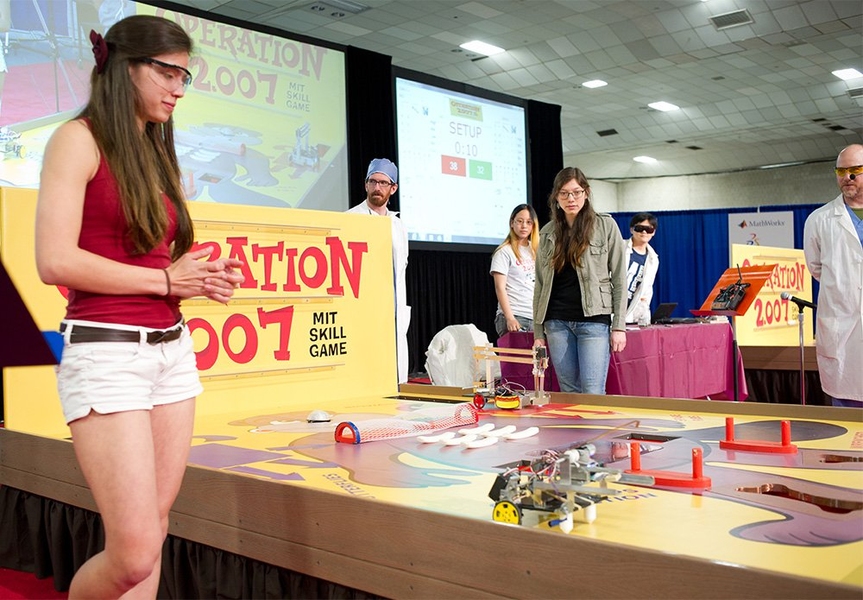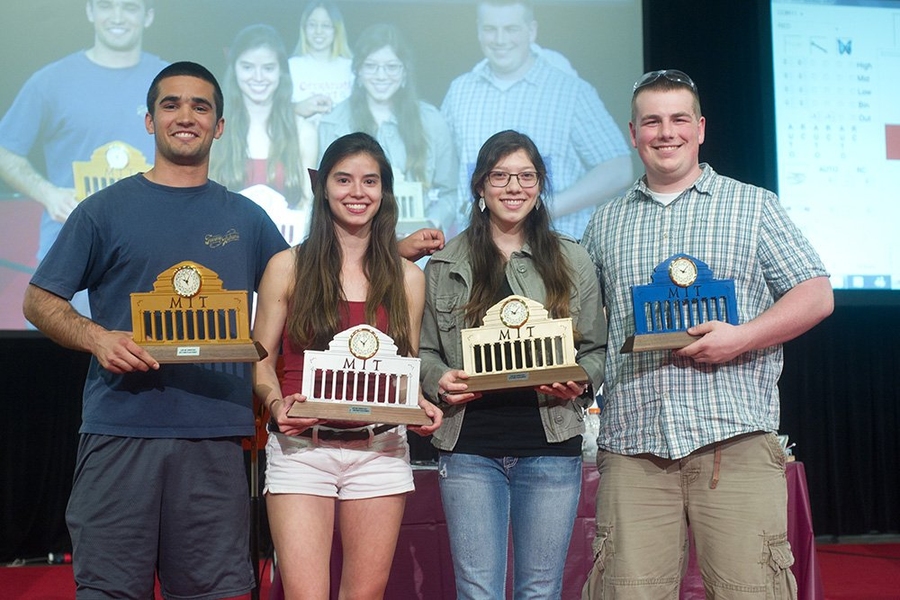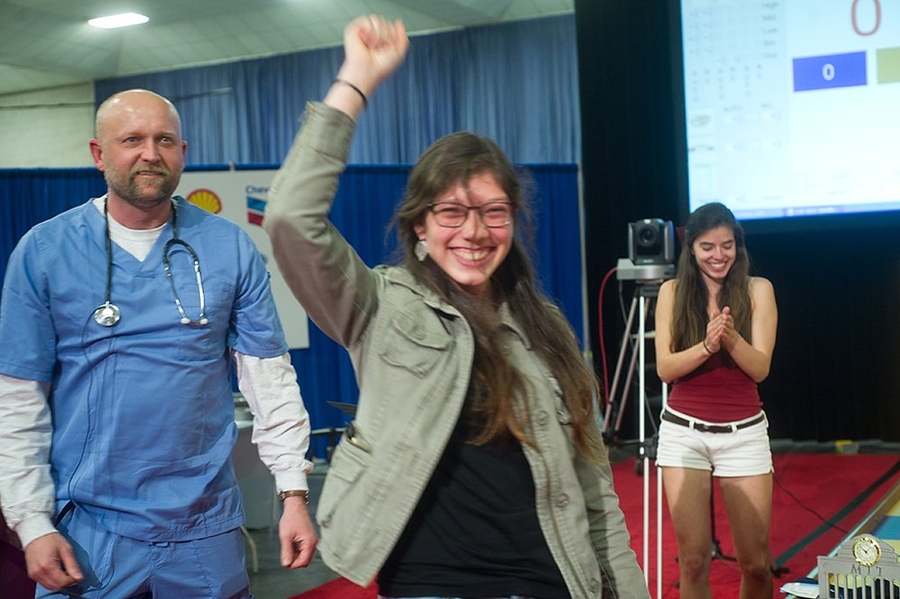Tim the Beaver, MIT’s mascot, is on an operating table and in need of several different medical procedures.
That scenario, a variation of the board game “Operation,” was the basis for this year’s final competition in 2.007 (Design and Manufacturing I), in which students design, build and operate small robots that compete in a variety of tricky tasks.
This year’s challenge, which featured several ways to earn points during two-minute matches, led to a wide variety of robot designs and strategies. In the end, the victory went to sophomore Aleksya Aguirre, whose “Hot Dog” robot took a slow-and-steady approach to carrying out two of the tasks — and succeeded in those almost every time.
For the first time in the course’s 43-year history, the final matchup in the single-elimination tournament, which started with 92 competitors, featured two women. The finalists, Aguirre and sophomore Sophie Seidell, are both mechanical engineering majors.
At the beginning of the semester, each 2.007 student who wishes to compete receives an identical kit of materials, motors, gears and controllers for use in creating a robot for the competition. Others in the 180-student class have the option of spending the semester designing an electric vehicle or an underwater vehicle.
With the help of several instructors and teaching assistants, each student develops a strategy and designs a robot; some — such as Seidell — design two robots to attempt different strategies in the competition.
Competition tasks varied in difficulty, and in point value. Removing a metal wrench from a rectangular pit at Tim’s ankle was worth 25 points. If the wrench was then placed on a shelf, that earned extra points — the higher the shelf, the higher the total. Performing “angioplasty” by inflating a balloon inside a stent scored points based on the diameter to which the balloon was successfully inflated.
Removing a “butterfly” from Tim’s stomach — a tricky operation, simulating laparoscopy — garnered 13 points. But these points carried a bonus: Only after retrieving a butterfly was a robot allowed to cross to the opponent’s side of the operating table to interfere with the other student’s robot, or to score extra points by grabbing the opponent’s wrench, butterfly or other parts.
That strategy was key in one quarterfinal match. Sophomore Jose Smith’s “magic man” robot was able to grab both his own wrench and butterfly, and then proceeded to block sophomore Ryan Fish’s “Loki” robot, which had already picked up a wrench, from scoring further.
The easiest task was retrieving one of Tim’s ribs and dumping it into a “biowaste pit” — worth just one point per rib. Two other tasks turned out to be so difficult that few students even attempted them, and none succeeded during the finals: stretching a rubber band between two posts, and performing an “fMRI” to identify a pattern of magnets beneath Tim’s head.
During most of the competition, students controlled their robots using TV remotes or controllers for either a videogame or a radio-controlled toy car. But each student also had the option of operating the robot autonomously for 30 seconds, and any points scored during this autonomous period were doubled.
While some had succeeded in earlier elimination matches, during the finals only one robot was able to score points in the autonomous mode: Sophomore David Flamholz’s robot snatched the wrench autonomously, gaining him 50 points and a wild round of applause and cheering from the audience.
As always, unexpected issues arose: A wheel came loose, a controller stopped working, or (quite often) one of the several pits on the board snagged a robot’s wheel.
Aguirre’s simple, focused strategy ultimately prevailed. Unlike many robots that were flexible enough to attempt several tasks, hers was designed to do just two things reliably: Pick up the wrench and one rib, and place them on a shelf. It worked almost every time.
“I decided on a simple design that would be consistent,” she said after her victory in her very first robotic contest. “I came into the class with no experience, and I was very intimidated.”
She’s not intimidated anymore. “I really enjoy the hands-on work,” she said.
That scenario, a variation of the board game “Operation,” was the basis for this year’s final competition in 2.007 (Design and Manufacturing I), in which students design, build and operate small robots that compete in a variety of tricky tasks.
This year’s challenge, which featured several ways to earn points during two-minute matches, led to a wide variety of robot designs and strategies. In the end, the victory went to sophomore Aleksya Aguirre, whose “Hot Dog” robot took a slow-and-steady approach to carrying out two of the tasks — and succeeded in those almost every time.
For the first time in the course’s 43-year history, the final matchup in the single-elimination tournament, which started with 92 competitors, featured two women. The finalists, Aguirre and sophomore Sophie Seidell, are both mechanical engineering majors.
At the beginning of the semester, each 2.007 student who wishes to compete receives an identical kit of materials, motors, gears and controllers for use in creating a robot for the competition. Others in the 180-student class have the option of spending the semester designing an electric vehicle or an underwater vehicle.
With the help of several instructors and teaching assistants, each student develops a strategy and designs a robot; some — such as Seidell — design two robots to attempt different strategies in the competition.
Competition tasks varied in difficulty, and in point value. Removing a metal wrench from a rectangular pit at Tim’s ankle was worth 25 points. If the wrench was then placed on a shelf, that earned extra points — the higher the shelf, the higher the total. Performing “angioplasty” by inflating a balloon inside a stent scored points based on the diameter to which the balloon was successfully inflated.
Removing a “butterfly” from Tim’s stomach — a tricky operation, simulating laparoscopy — garnered 13 points. But these points carried a bonus: Only after retrieving a butterfly was a robot allowed to cross to the opponent’s side of the operating table to interfere with the other student’s robot, or to score extra points by grabbing the opponent’s wrench, butterfly or other parts.
That strategy was key in one quarterfinal match. Sophomore Jose Smith’s “magic man” robot was able to grab both his own wrench and butterfly, and then proceeded to block sophomore Ryan Fish’s “Loki” robot, which had already picked up a wrench, from scoring further.
The easiest task was retrieving one of Tim’s ribs and dumping it into a “biowaste pit” — worth just one point per rib. Two other tasks turned out to be so difficult that few students even attempted them, and none succeeded during the finals: stretching a rubber band between two posts, and performing an “fMRI” to identify a pattern of magnets beneath Tim’s head.
During most of the competition, students controlled their robots using TV remotes or controllers for either a videogame or a radio-controlled toy car. But each student also had the option of operating the robot autonomously for 30 seconds, and any points scored during this autonomous period were doubled.
While some had succeeded in earlier elimination matches, during the finals only one robot was able to score points in the autonomous mode: Sophomore David Flamholz’s robot snatched the wrench autonomously, gaining him 50 points and a wild round of applause and cheering from the audience.
As always, unexpected issues arose: A wheel came loose, a controller stopped working, or (quite often) one of the several pits on the board snagged a robot’s wheel.
Aguirre’s simple, focused strategy ultimately prevailed. Unlike many robots that were flexible enough to attempt several tasks, hers was designed to do just two things reliably: Pick up the wrench and one rib, and place them on a shelf. It worked almost every time.
“I decided on a simple design that would be consistent,” she said after her victory in her very first robotic contest. “I came into the class with no experience, and I was very intimidated.”
She’s not intimidated anymore. “I really enjoy the hands-on work,” she said.
